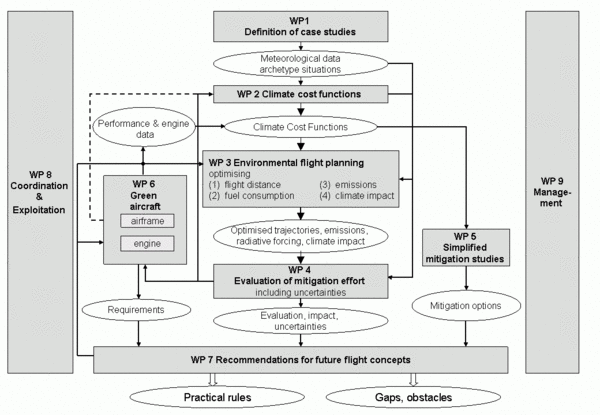| |
About REACT4C
Despite significant progress has been made in reducing the
specific emissions of aircraft, in particular CO2, the absolute
emissions have been increasing rapidly during the recent decades
and are projected to continue to grow. Furthermore, aviation
substantially impacts upon climate from non-CO2 effects such as
ozone formation and methane destruction from aviation's NOx emissions,
the formation of contrails and contrail cirrus, the emission of H2O
at high altitudes, emission of aerosols (e.g., soot) and aerosol
precursors (e.g., SOx), which are directly radiatively active and
which modify cloudiness and cloud micro-physical and radiative properties.
Current flight planning is performed with the objectives of achieving
maximum punctuality or minimizing the operational costs, whereas the
target of minimal fuel consumption, minimal CO2 emissions or minimal
climate impact has a lower priority.
Impact of aircraft non-CO2 emissions on the atmospheric composition
and on climate depends on the altitude and location of the emissions.
Therefore climate impact via NOx, contrails and contrails cirrus can be
reduced e.g. by flying lower and by avoiding contrail regions. On the other
hand this results in a higher fuel burn and hence in higher CO2 emissions.
The project REACT4C will perform an optimisation approach for alternative
or environmental flight planning in order to assess the potential for reducing
fuel consumption, CO2 emissions and climate impact from aviation.
Objectives
In order to reduce aviation's emissions and improve its environmental
compatibility, the project REACT4C will address those inefficiencies which
exist in the aviation system with respect to fuel consumption and emissions
by investigating the potential of alternative flight routing for lessening
the atmospheric impact of aviation.
Hence the main objectives of REACT4C are
- to explore the feasibility of adopting flight altitudes and flight routes that lead to reduced fuel consumption and emissions, and lessen the environmental impact;
- to estimate the overall global effect of such ATM measures in terms of climate change.
The objective of REACT4C is to demonstrate that environmentally friendly
flight routing is feasible, but does not address the operational implementation
of such advanced ATM procedures. The latter would require much more time than is
available during the present project. However, REACT4C will deliver substantial
scientific foundation and operational specification for novel ATM procedures, which
might be explored in a later phase of the SESAR JU. Analogously, REACT4C will deliver
fundamental concepts of aircraft that are better suited for environmentally flight
routing, which will have the potential to enter the Clean Sky JTI in a later phase.
Work Packages

Graphical presentation of project structure, showing work packages and interaction.
|

